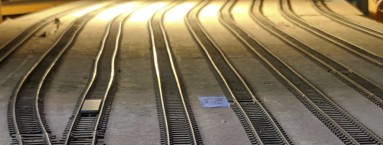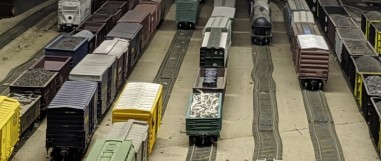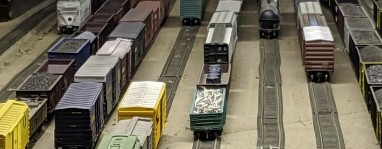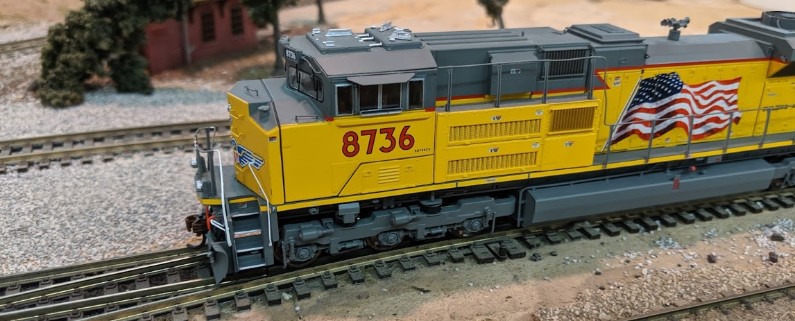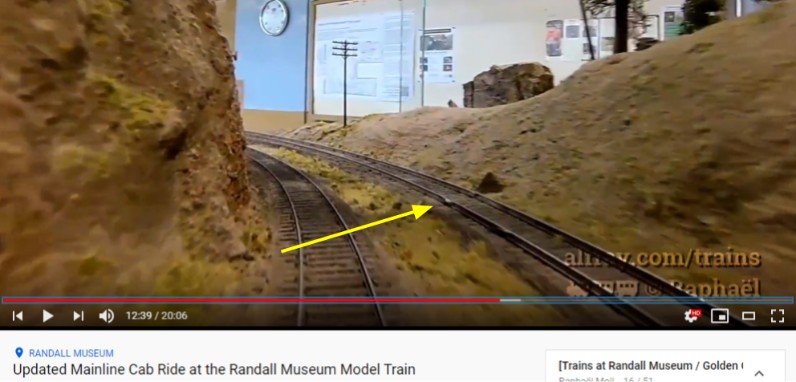The Randall Museum in San Francisco hosts a large HO-scale model model railroad. Created by the Golden Gate Model Railroad Club starting in 1961, the layout was donated to the Museum in 2015. Since then I have started automatizing trains running on the layout. I am also the model railroad maintainer. This blog describes various updates on the Randall project and I maintain a separate blog for all my electronics not directly related to Randall.
A few weeks ago, Jim got these two Bachmann SD70, and I tried them on the automation. They work very well, with some nice sound and lights. I was even surprised to see that IL 1072 had alternating ditching lights that come on automatically when the automation slows it down with the bell at the Sonora station!
The other engine he got is Reading 1067:
Click here to continue reading...
Looks like the Passenger train derailed:
My first reaction was to try the engine with just the caboose, and…
Click here to continue reading...
Back in the “Warp Drive” entry from 11-02, I was mentioning how some of the track from Napa yard had very badly warped.
It is worth noting the warping issue also somewhat affected the Richmond yard. I had also noticed that somehow the front panel of the Stockton Yard panel had a similar issue, the panel no longer laying flat on its support.
Today I got it to work on this, and to my surprise the track had started fixing itself, here’s a side-by-side comparison:
Napa Yard Before |
Napa Yard After |
Richmond Yard Before |
Richmond Yard After |
Also the front panel of the Stockton Yard panel was not warped anymore:
Click here to continue reading...
I don’t usually blog about all the little things that happen on the Randall Museum’s train layout here. There’s been a few in the couple past months that I did not blog about so let’s compile them here for the sake of completeness. While I get some compliments for the automation running smoothly, I want to keep educating people that this does not happen magically. This is an old layout and it does require quite a bit of maintenance.
Let’s look at the most recent maintenance tasks:
2019-09-25:
UP Passenger train derailed on turnout T311 during automation. I took the opportunity to switch UP engine 8736 with its sibling 8749 as my goal is to swap the engines every few months to give them a rest.
Click here to continue reading...
2019-11-02 - Warp Drive
Category RandallI’ve noticed this in the Napa yard last month:
First time I noticed was on 2019-10-12 and that was definitely new.
It reminds me of the Earthquake Trail at Point Reyes, yet I am sure we are not modeling the San Andreas Fault here. And viewed from the other side, it isn’t any better:
Click here to continue reading...
Last week, Saturday Operators ran their trains, and overall had a good session. I’m being told though that when Allen ran his UP Challenger #3977, it did a couple loops fine on the layout then he had it sitting in the yard and for some reason it would not run anymore.
Rather than relying on random conjectures, yesterday I had him bring the engine back on the layout and we investigated methodologically. First we tried the programming track, and his engine ran fine there. Then we placed it on the mainline at the Stockton Yard and it… did not run. Which is what he experienced the week before. We tried several combinations to try to isolate something. Maybe due to the NCE Controller? Nope. We placed the engine on the layout one the Napa yard and it was working fine. We then brought it back to the mainline at Stockton Yard and it would not run.
By “not running” it was interesting to see the engine cab internal light would light up, and it would make start/stop sounds. Some smoke was generated so clearly the heater element had power. But no movement and no corresponding chuffing sound.
The engine was sitting on block B21, controlled by the Valley Panel 1. Out of curiosity I turned off that block and… surprise, the engine still had lights on. Wait, what?
Click here to continue reading...
Affected |
Turnout T410 between Walong and tunnel. |
Description |
Broken point. |
Summary Fix |
Spike the point. |
Description of Issue
The point had broken on turnout T410, causing some engines to derail or get stuck on the rod. William fixed that on the spot by spiking the point. Since the turnout is on the mainline we don’t want trains to get stuck here.
Click here to continue reading...
I enjoy doing cab ride videos on model train layouts. That’s sort of an understatement since I have 17 cab rides now on my channel.
That said, besides just the style, I find cab rides particularly useful as inspection tools. The latest discovery I made is this:
This shows there’s a track feeder soldered to the rails on the inside of the curve, one thing I did not notice when looking at the rails on the spot.
This is particularly useful as this track currently exhibits a rather annoying and elusive dead spot. The track “obviously” has power except when a train comes from the tunnel towards Sultan, where it suddenly loses power. That means now I can crawl under the layout and check whether that track feeder is properly soldered, and I’ll reference that photo to figure the location from under the plywood -- which is never something I’m looking forward to.
Another possibility is that the issue comes from a typical cold solder joint as I already fixed in other places, except I do not know where the next track segment junction is, and this location does not make it easy to access any of the track.
Here’s the full video:
The “Auxiliary Power Supply” is a gray box that used to be located on the other side of the wall behind the automation computer. It has now been moved next to the fascia, just on the other side of the wall where the DCC Power Switch is located. This will make it easier to reset when it trips, which it sometimes does.
It has 3 outputs which provide:
- 24 V DC for the DC / DCC relays.
- 12 V AC for an accessory bus going under the layout, powering various little things (example: tortoise from the branchline, ac-dc converter for the Sonora signal bridge, etc.)
- 6 V AC for … definitely some lights.
The next step is to put a green LED on the front of the power supply. This will make it even more obvious when it has tripped. Also replace the blue painter tape by a proper label. I added the LED but instead went for a contraption like this:
Click here to continue reading...
Affected |
Block B350 up the mountain. |
Description |
Joiner solder gone bad. |
Summary Fix |
Resolder the joiner. |
Description of Issue
We have had elusive electrical issues with block B350 for a little while. Trains would stop when going up or down the mountain. This is likely due to a broken solder in the track power feeds -- as the track warms up or as the trains put pressure on it, it can be enough to make or break the contact and lose power. Or it could be an issue with the track power on the panel with the track toggles, as we had experienced issues with that last year too.
Although it’s easy to get a rough idea of where the trains lose power, it’s a lot harder to get near the track for a close inspection. A lot of these power feed wires are also hidden in the track scenery or ballast.
Click here to continue reading...



